Sundararaja D. The Discrete Fourier Transform. Theory, Algorithms and Applications
Подождите немного. Документ загружается.


334
The Complex Numbers
•-1+/J
,-2+yO
.-2-yi |
So
2+/2
,o+y
1
0+yO
2-/2
J
m
-2-1 0 1 2
Fig. A.l The complex plane with some complex numbers.
than using vector algebra or vector diagrams. When the second of the pair
of ordered numbers is zero, it is equivalent to a real number. The set of
real numbers is a subset of the complex numbers.
Rectangular Form
Figure A.l shows some complex numbers in the complex plane. Remember
that the negative symbol '-' is used to represent n radians or 180 degrees
(the angle formed by the positive and the negative real axis). Similarly,
the symbol j is used to indicate an angle of \ radians or 90 degrees. The
rectangular form of a complex number is given by x + jy where x and y are
real numbers and j — y/—l since jj = j
2
=
—1,
a rotation of 180 degrees.
The number x is called the real part and y is called the imaginary part of
the complex number and j is called the imaginary unit. If the real part of
a complex number is zero (the number 0 + jl), it is called a pure imaginary
number (a number on the imaginary axis). If the imaginary part is zero
(the number -2+jO), it is called a pure real number (a number on the real
axis).
Let Zi = xi + jyi and z
2
— x
2
+ J2/2- The complex numbers z\ and z
2
are equal if and only if x\
—
x
2
and y\ =yi-
Addition
z
3
= z\ + z
2
, where z
3
= (xi + x
2
) + j(yi +1/2)
Subtraction
z
3
=
zi - z
2
, where z
3
= (xi - x
2
) + j(yi - 2/2)

Polar Form
335
Multiplication
23 = ziz
2
, where z
3
= (xix
2
- 2/12/2) + j(xiy
2
+ x
2
yi)
Conjugation
The conjugate of a complex number z = x+jy, denoted by z*, is defined
asz* = x—jy, that is the imaginary part is negated. The complex conjugate
pair 2 + j2 and 2
—
j2 is shown in Fig. A.l. z + z* = 2x, z
—
z*
—
j2y, and
zz* = x
2
+ y
2
. The complex conjugate of an expression is equivalent to the
expression with every complex quantity conjugated.
(Zl
+Z
2
)*
=Z*+Z*,
(Zx - Z
2
)* = Z* - Z*, (Z!Z
2
)* =
Z*Z
2
.
Division
_ zi _ ziz* _ {x
x
x
2
+ 2/12/2) + j(x
2
yi -
y
2
xi)
z
3 — — — T — o~, 9
Z
2
Z
2
Z^ X\ + J/2
Polar Form
A point in the complex plane can also be represented by its distance from
the origin, called the magnitude (the magnitude is always a positive num-
ber),
and the angle, called the argument, formed by the line joining the
point and the origin, and the positive real axis. The magnitude A and the
argument 8 can be obtained from the rectangular form x + jy as
A = +x/(a;
2
+ 2/
2
), 9 = tan""
1
^
x
The polar form is written as Aid. As ALQ = AL(Q + 2kir), where k is an
integer, the value of the argument 6 such that — it < 6 <
7T
is called its prin-
cipal value. From polar representation, the components of the rectangular
form can be derived as x = ^4cos0 and y = AsinO. Using Euler's identity,
we get
Ae
je
= Acos0 + jAsinO
The expression on the left is called the exponential form of the complex
number. The multiplication and division operations are relatively easier to
carry out in the polar or exponential form.
z
3
= z
x
z
2
= A
x
e^A
2
e
i6
* =
A
1
A
2
e
j
^
+e
^

336
The Complex Numbers
z
2
A
2
e^ A
2
Powers and Roots
Let z = re
je
. Then, z
N
=
(re
je
)
N
= r
N
e
jm
, where N > 1 is an integer.
Since 2kir can be added to the argument of a complex number, where k is
an integer, without changing its value and replacing N by jj, we get for
z^O
X 1
„•
2fcir + 9
£
W
•=. fit Ql N .
Expanding the equation, we get the N distinct roots as
y~z=
^(cos^±f+jsin^±f), fc = 0,l,...,JV-l (A.l)
where %/f is the real positive root. For example, letting r
—
1, 6 =
TT,
and
N = 2, with
A;
= 0, we get
(cos-+jsin-) =0 + jl
and, with k = 1, we get
. 37T . . 37T.
(cos y+jsiny)=0-jl
The square of both the roots equals e*-
7
^ = —
1.
The Roots of Unity
Of particular interest to DFT are the N roots of unity, that is the solutions
of the equation x
N
—
1 = 0. In mathematical literature, the computation
of the DFT is referred to as the evaluation of a polynomial of degree N
—
1
at N values of the roots of unity. The usual representation of a polynomial
is with its coefficients. For example, the representation of the polynomial
2 + 3x with its values at the two roots of unity
(1,
-1) is (5, -1), obtained
by evaluating the polynomial at 1 and
-1.
In electrical engineering litera-
ture,
the computation of the DFT is referred to as the evaluation of the
^-transform at JV equally spaced points on the unit circle.

The Complex Exponential, and Cosine and Sine Functions 337
By letting r = 1 and 6 = 0 in Eq. (A.l), we get N complex numbers,
called the iVth roots of unity, as
VI = (cos ^+ j sin ^),
A
= 0,1,...,JV-1
With N = 2, the roots are 1 + jO and -1 + jO. With N = 3, the roots
are 1 + jO, -| +
j^,
and -\ -
j^.
With JV = 4, the roots are 1 + jO,
0 + jl,
—1
+ jO, and 0 - jl. The first eight roots, with N = 32, are shown
in Fig. A.2. By using appropriate signs, the other roots can be obtained.
These are the values of
e
m"
= wi
2
k
,
fc
= o,i,...,3i
The Complex Exponential, and Cosine and Sine Functions
Let us express the complex exponential in the series form. The series rep-
resentation is similar to that of a real exponential.
6 1
+ W";+ 2! 3! 4! ' (r)!
The exponent can be any complex number, but our interest is primarily in
the complex exponential with a pure imaginary exponent. One half of the
numbers in the series are pure real and the other half pure imaginary. If
we group the two sets, we get
•»><i-£
+
S--)
+
i(#-£
+
£-->
The two expressions in parenthesis on the right-hand side are series ex-
pansions for cosine and sine functions, respectively. Therefore, we get the
Euler's identity
e
je
= cos 6 + j sin
d
The Representation of a Real Sinusoid
Figure A.2 shows thirty-two equidistant points of a circle of radius one and
center at origin. By definition, the projection of any point on the real axis
is cos#, where 8 is the angle formed by the line from the origin to the point
and the positive real axis. The line between a point on the circle and the
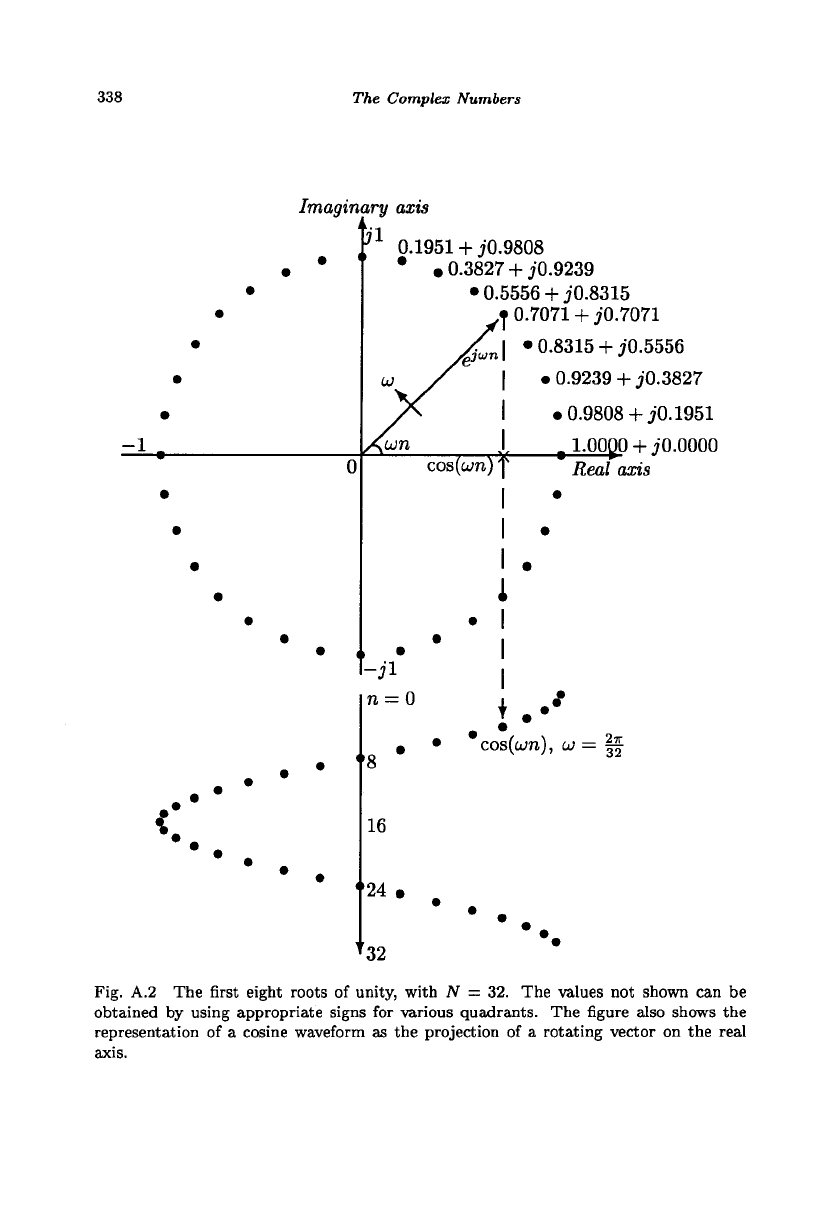
338
The Complex Numbers
Imaginary axis
k.
fl
0.1951+
J0.9808
* •
0.3827
+
j0.9239
•
0.5556+
J0.8315
,f
0.7071
+
j'0.7071
,
]un
\ •
0.8315
+
J0.5556
| •
0.9239
+
jO.3827
cos
»•
I
•
0.9808
+
j0.1951
J- .i-oopo
+
JO.OOOO
H
t
Real axis
I
*
I
•
I
•
1
• I
i.-'
cos(a;n),
LJ
= ||
-J'l
n = 0
8 *
16
24.
*32
Fig. A.2 The first eight roots of unity, with N = 32. The values not shown can be
obtained by using appropriate signs for various quadrants. The figure also shows the
representation of a cosine waveform as the projection of a rotating vector on the real
axis.
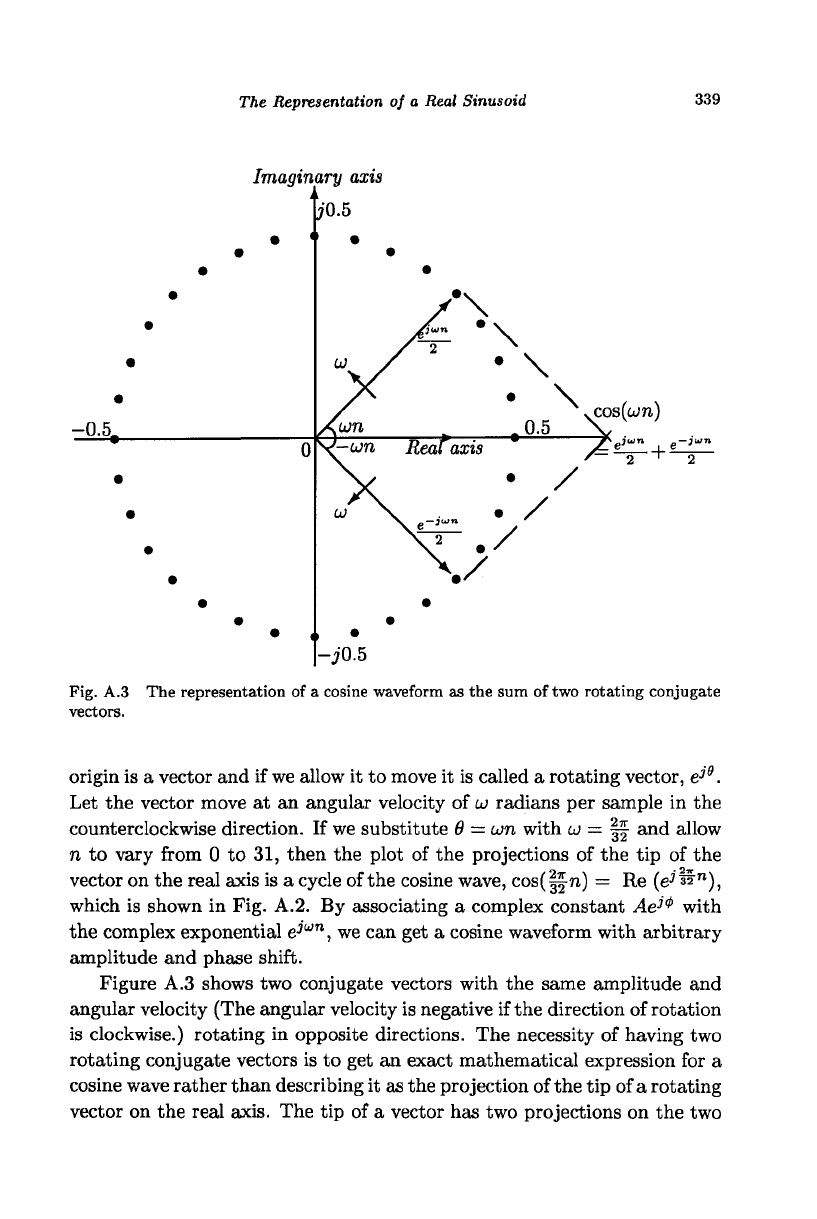
The Representation of a Real Sinusoid
339
Imaginary axis
';'0.5
0.5 ^
S(UJn)
2 ' 2
Fig. A.3 The representation of a cosine waveform as the sum of two rotating conjugate
vectors.
origin is a vector and if we allow it to move it is called a rotating vector, e
j9
.
Let the vector move at an angular velocity of
u>
radians per sample in the
counterclockwise direction. If we substitute 6
—
wn with u = |f and allow
n to vary from 0 to 31, then the plot of the projections of the tip of the
vector on the real axis is a cycle of the cosine wave, cos(|f-n) = Re [e?"&"),
which is shown in Fig. A.2. By associating a complex constant Ae^ with
the complex exponential e
Jwn
, we can get a cosine waveform with arbitrary
amplitude and phase shift.
Figure A.3 shows two conjugate vectors with the same amplitude and
angular velocity (The angular velocity is negative if the direction of rotation
is clockwise.) rotating in opposite directions. The necessity of having two
rotating conjugate vectors is to get an exact mathematical expression for a
cosine wave rather than describing it as the projection of the tip of a rotating
vector on the real axis. The tip of a vector has two projections on the two
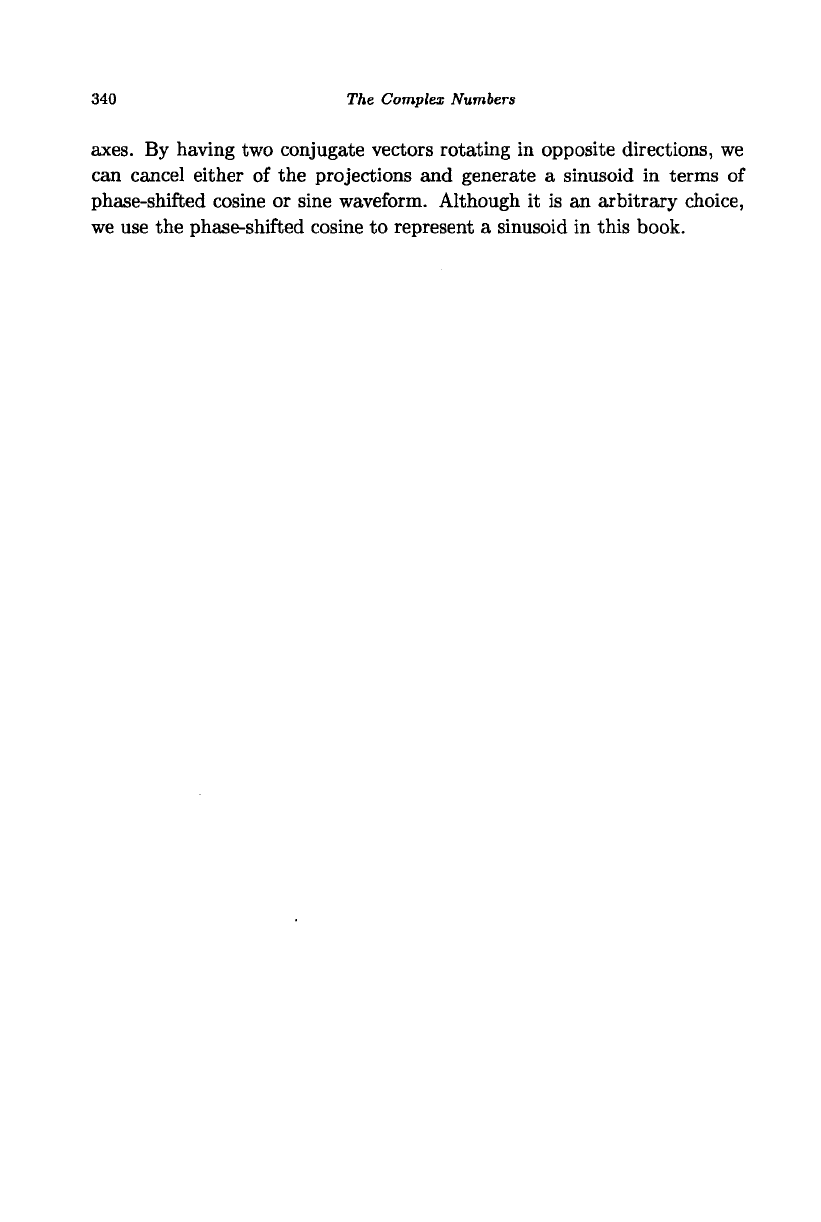
340
The Complex Numbers
axes.
By having two conjugate vectors rotating in opposite directions, we
can cancel either of the projections and generate a sinusoid in terms of
phase-shifted cosine or sine waveform. Although it is an arbitrary choice,
we use the phase-shifted cosine to represent a sinusoid in this book.

Appendix B
The Measure of Computational
Complexity
An algorithm is a systematic procedure to solve a problem. As there can
be many algorithms to solve a problem, a measure is required to evaluate
the relative merits of the algorithms. While the ultimate measure is the
execution time of the algorithms on the same computer, however, we need
a measure that is independent of the computer used although it may be
less precise. Such a measure is given by a function that indicates the rate
of increase in the number of major operations, such as multiplications,
additions, or comparisons, as the number of elements in the input data is
increased. For example, if the number of operations required to execute an
algorithm is proportional to JV, the data size, then it is referred to have a
computational complexity of 0(N). The constant of proportionality and
any terms of a lower order are ignored. The growth of the computational
complexity of various orders is shown in Fig. B.l. For a large JV, the
execution time will be proportional to the computational complexity. For
very small JV, due to reduced overhead operations, an algorithm with an
higher order of complexity could run faster. When comparing algorithms
of the same order of complexity, we have to consider several factors such
as run-time, overhead operations, memory required, regularity, simplicity,
stability, and numerical accuracy to find out which algorithm is practically
better.
The computational complexity of directly evaluating the 1-D DFT is
0(JV
2
) and that of using fast 1-D DFT algorithms is 0(JVlog
2
JV). The
computational complexity of directly evaluating the 2-D DFT is 0(JV
4
).
The computational complexity of directly evaluating the 2-D DFT using
the row-column method is
0(N
3
).
The computational complexity of evalu-
341
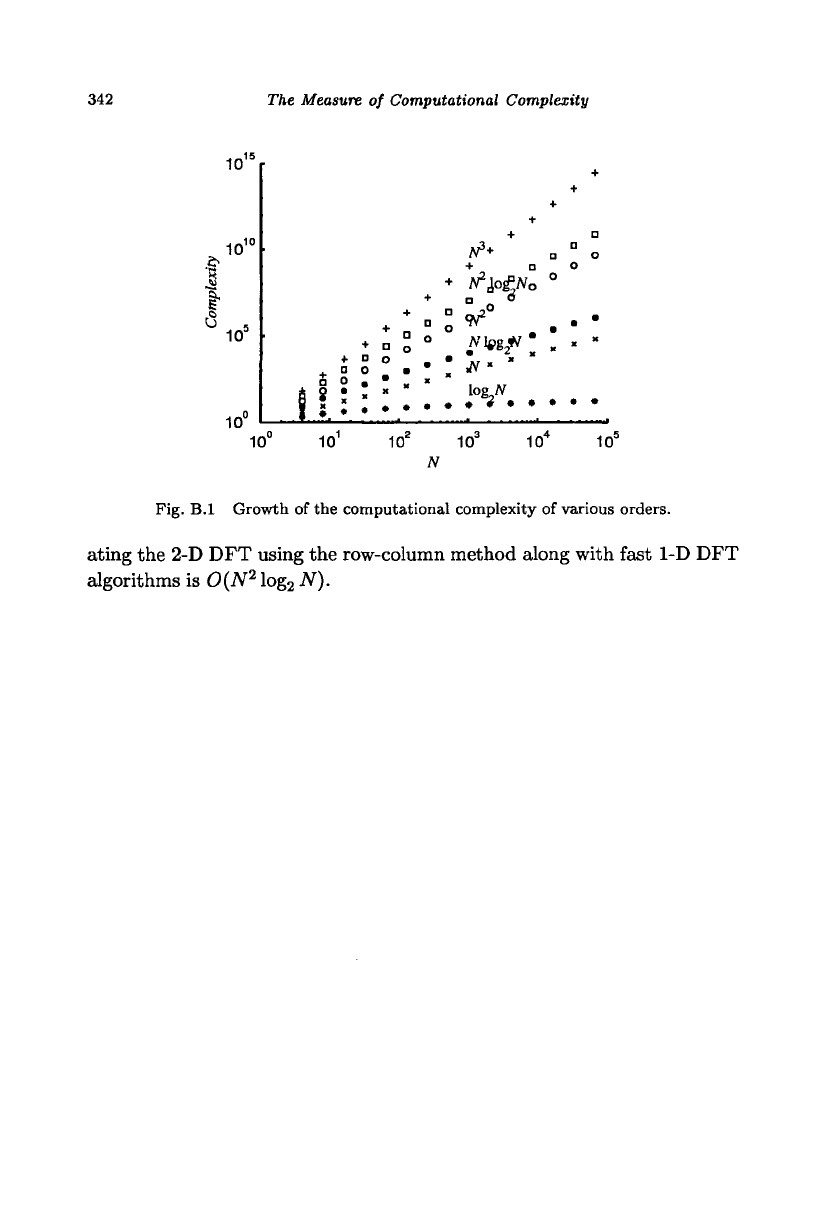
342
The Measure
of
Computational Complexity
10
10
lu
Complex
o
-m"
J
1
a
o
•
+
D
0
•
+
D
•
X
+
D
O
•
X
+
D
O
X
+
+
+
+
+
n
A/
3
*
D
" o
+
• o
°
„ °
NlBSf
, " "
_
• * X
log^V
10"
10' 10'
10
J
N
10'
10°
Fig.
B.l
Growth
of
the computational complexity
of
various orders.
ating the 2-D DFT using the row-column method along with fast 1-D DFT
algorithms is 0(N
2
log
2
N).
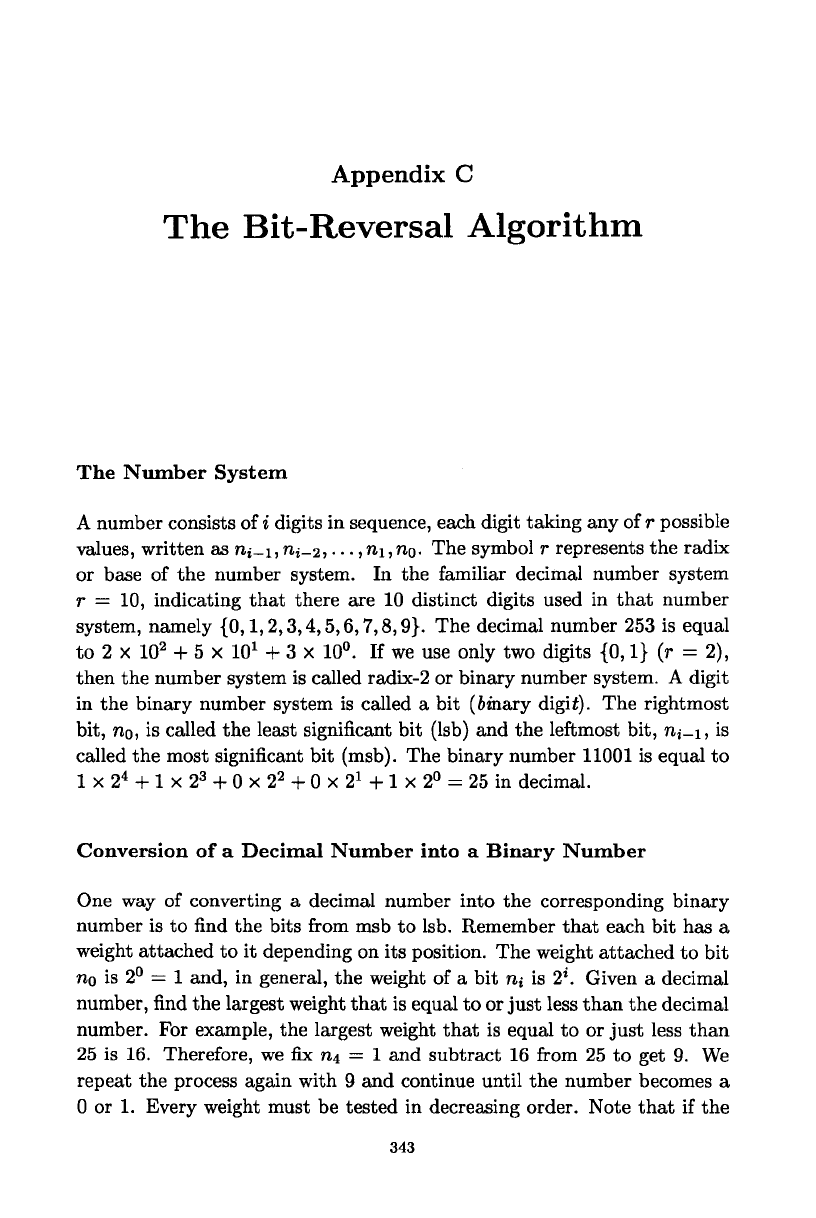
Appendix C
The Bit-Reversal Algorithm
The Number System
A number consists of i digits in sequence, each digit taking any of r possible
values, written as ni-i,rii-2,
• •
.,rii,no- The symbol r represents the radix
or base of the number system. In the familiar decimal number system
r = 10, indicating that there are 10 distinct digits used in that number
system, namely {0,1,2,3,4,5,6,7,8,9}. The decimal number 253 is equal
to 2 x 10
2
+ 5 x 10
1
+ 3 x 10°. If we use only two digits {0,1} (r = 2),
then the number system is called radix-2 or binary number system. A digit
in the binary number system is called a bit (fiinary digit). The rightmost
bit, no, is called the least significant bit (lsb) and the leftmost bit, rij_i, is
called the most significant bit (msb). The binary number 11001 is equal to
1 x 2
4
+ 1 x 2
3
+ 0 x 2
2
+ 0 x 2
1
+ 1 x 2° = 25 in decimal.
Conversion of a Decimal Number into a Binary Number
One way of converting a decimal number into the corresponding binary
number is to find the bits from msb to lsb. Remember that each bit has a
weight attached to it depending on its position. The weight attached to bit
n
0
is 2° = 1 and, in general, the weight of a bit n» is 2*. Given a decimal
number, find the largest weight that is equal to or just less than the decimal
number. For example, the largest weight that is equal to or just less than
25 is 16. Therefore, we fix m = 1 and subtract 16 from 25 to get 9. We
repeat the process again with 9 and continue until the number becomes a
0 or 1. Every weight must be tested in decreasing order. Note that if the
343
